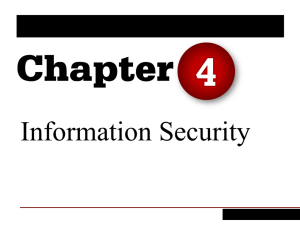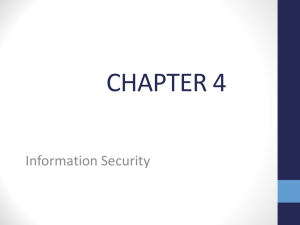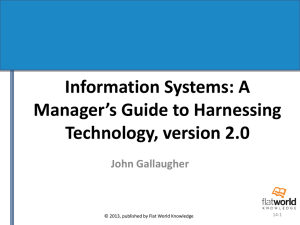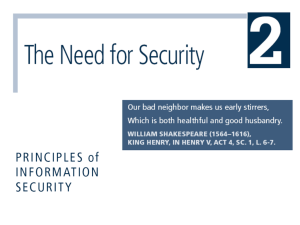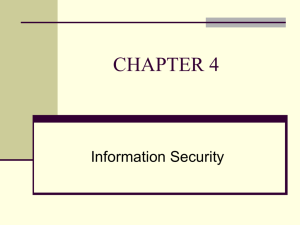ch07
advertisement
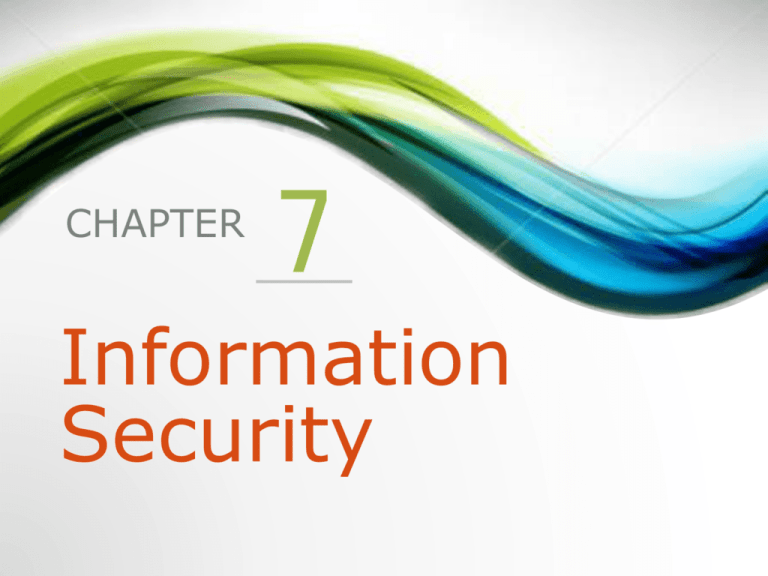
CHAPTER 7 Information Security 1. Introduction to Information Security 2. Unintentional Threats to Information Systems 3. Deliberate Threats to Information Systems 4. What Organizations Are Doing to Protect Information Resources 5. Information Security Controls >>> 1. Identify the five factors that contribute to the increasing vulnerability of information resources, and provide a specific example of each one. 2. Compare and contrast human mistakes and social engineering, and provide a specific example of each one. 3. Discuss the 10 types of deliberate attacks. >>> 4. Define the three risk mitigation strategies, and provide an example of each one in the context of owning a home. 5. Identify the three major types of controls that organizations can use to protect their information resources, and provide an example of each one. OPENING > • Shodan: Good Tool or Bad Tool? 1. Is Shodan more useful for hackers or for security defenders? Provide specific examples to support your choice. 2. What impact should Shodan have on the manufacturers of devices that connect to the Internet? 3. As an increasingly large number of devices are connected to the Internet, what will Shodan’s impact be? Provide examples to support your answer. 7.1 Introduction to Information Security Information Security Threat Exposure Vulnerability Five Key Factors Increasing Vulnerability • Cybercrime • • • • • Five Key Factors Increasing Vulnerability 1. Today’s interconnected, interdependent, wirelessly networked business environment 2. Smaller, faster, cheaper computers and storage devices 3. Decreasing skills necessary to be a computer hacker 4. International organized crime taking over cybercrime 5. Lack of management support 7.2 Unintentional Threats to Information Systems • Human Errors • Social Engineering Human Errors • Higher employee levels = higher levels of security risk • Most Dangerous Employees • Human Mistakes Dangerous Employees • Two organizational areas pose the greatest risk – Human Resources – Information Systems • Janitors and Guards Frequently Overlooked Figure 7.1 Security Threats: Human Mistakes • Carelessness with laptops • Carelessness with computing devices • Opening questionable e-mails • Careless Internet surfing • Poor password selection and use • Carelessness with one’s office Human Mistakes (continued) • Carelessness using unmanaged devices • Carelessness with discarded equipment • Careless monitoring of environmental hazards Table 7.1: Human Mistakes Social Engineering • Social Engineering: – an attack in which the perpetrator uses social skills to trick or manipulate legitimate employees into providing confidential company information such as passwords. 7.3 Deliberate Threats to Information Systems 1. Espionage or Trespass 2. Information Extortion 3. Sabotage or Vandalism 4. Theft of Equipment or Information 5. Identity Theft 6. Compromises to Intellectual Property 7.3 Deliberate Threats to Information Systems (continued) 7. Software Attacks 8. Alien Software 9. Supervisory Control and Data Acquisition Attacks 10. Cyberterrorism and Cyberwarfare Compromises to Intellectual Property • • • • Intellectual Property Trade Secret Patent Copyright Software Attacks: Three Categories 1. Remote Attacks Requiring User Action – Virus – Worm – Phishing Attack – Spear Phishing Software Attacks: Three Categories (continued) 2. Remote Attacks Needing No User Action – Denial-of-Service Attack – Distributed Denial-of-Service Attack Software Attacks: Three Categories (continued) 3. Attacks by a Programmer Developing a System – Trojan Horse – Back Door – Logic bomb ’S ABOUT BUSINESS 7.1 • Stealing Cash from ATMs with Text Messages 1. Other than the ones mentioned in this case, what countermeasures could banks take to defend against ATM hacks such as these? 2. Why are some banks still using Windows XP on their ATMs, when newer, more secure operating systems are available? Alien Software • • • • • Adware Spyware Spamware Spam Cookies ’S ABOUT BUSINESS 7.2 • The Mask 1. Discuss the implications of the targeted nature of the Careto malware. 2. Analyze the statement: “Nations use malware such as Careto when their only alternative is to go to war.” 3. Discuss the impacts that such sophisticated malware could have on all of us. 7.4 • • • • What Organizations Are Doing to Protect Information Resources Risk Risk Management Risk Analysis Risk Mitigation Table 7.3: The Difficulties in Protecting Information Resources Risk Management Three Processes of Risk Management: 1. risk analysis 2. risk mitigation 3. controls evaluation Risk Analysis Three Steps of Risk Analysis 1. assessing the value of each asset being protected 2. estimating the probability that each asset will be compromised 3. comparing the probable costs of the asset’s being compromised with the costs of protecting that asset Risk Mitigation • Risk Acceptance • Rick Limitation • Risk Transference 7.5 • • • • • Information Security Controls Physical Controls Access Controls Communications Controls Business Continuity Planning Information Systems Auditing Figure 7.2: Where Defense Mechanisms are Located. Physical Controls • • • • Walls Doors Fencing Gates • • • • Locks Badges Guards Alarm Systems Access Controls • Authentication • Authorization – Something – Something – Something – Something the the the the user user user user is has does knows Communications Controls • • • • • • Firewall Anti-malware Systems Whitelisting Blacklisting Encryption Virtual Private Network (VPN) Figure 7.3: (a) Basic Firewall for Home Computer. (b) Organization with Two Firewalls and Demilitarized Zone Figure 7.4: How Public-key Encryption Works Figure 7.5: How Digital Certificates Work. Figure 7.6: Virtual Private Network (VPN) and Tunneling ’S ABOUT BUSINESS 7.3 • A Tale of Two Cybersecurity Firms 1. 2. 3. 4. Describe why it was so important for law enforcement officials to capture all 96 Rustock command servers at one time. If the perpetrators of Rustock are ever caught, will it be possible to prove that they were responsible for the malware? Why or why not? Support your answer. Mandiant has stated that it has no definitive proof that Chinese hackers are behind the numerous attacks on U.S. companies and government agencies. Is such proof even possible to obtain? Why or why not? Support your answer. If such proof were possible to obtain, would it matter? Why or why not? Support your answer. Discuss the advantages for FireEye of purchasing Mandiant. Then, discuss the benefits that Mandiant obtained from the sale. Business Continuity Planning • Business Continuity • Business Continuity Plan Information Systems Auditing • Internal Audits • External Audits • Three Categories of IS auditing procedures Three Categories of IS auditing procedures: • Auditing Around the Computer • Auditing Through the Computer • Auditing With the Computer
